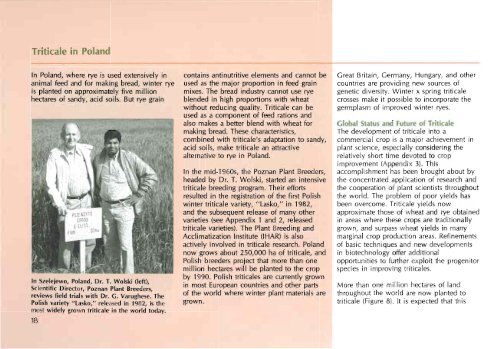U - Search CIMMYT repository
U - Search CIMMYT repository
U - Search CIMMYT repository
You also want an ePaper? Increase the reach of your titles
YUMPU automatically turns print PDFs into web optimized ePapers that Google loves.
Triticale in Poland<br />
In Poland, where rye is used extensively in<br />
animal feed and for making bread, winter rye<br />
is planted on approximately five million<br />
hectares of sandy, acid soils. But rye grain<br />
In Szelejewo, Poland, Dr. T. Wolski (left),<br />
Scientific Director, Poznan Plant Breeders,<br />
reviews field trials with Dr. G. Varughese. The<br />
Polish variety "lasko," released in 1982, is the<br />
most widely grown triticale in the world today.<br />
18<br />
contains antinutritive elements and cannot be<br />
used as the major proportion in feed grain<br />
mixes. The bread industry cannot use rye<br />
blended in high proportions with wheat<br />
without reducing quality. Triticale can be<br />
used as a component of feed rations and<br />
also makes a better blend with wheat for<br />
making bread. These characteristics,<br />
combined with triticale's adaptation to sandy,<br />
acid soils. make triticale an attractive<br />
alternative to rye in Poland.<br />
In the mid-1960s, the Poznan Plant Breeders,<br />
headed by Dr. T. Wolski, started an intensive<br />
triticale breeding program. Their efforts<br />
resulted in the registration of the first Polish<br />
winter triticale variety, "Lasko," in 1982,<br />
and the subsequent release of many other<br />
varieties (see Appendix 1 and 2, released<br />
triticale varieties). The Plant Breeding and<br />
Acclimatization Institute (IHAR) is also<br />
actively involved in triticale research. Poland<br />
now grows about 250,000 ha of triticale, and<br />
Polish breeders project that more than one<br />
million hectares will be planted to the crop<br />
by 1990. Polish triticales are currently grown<br />
in most European countries and other parts<br />
of the world where winter plant materials are<br />
grown.<br />
Great Britain, Germany, Hungary, and other<br />
countries are providing new sources of<br />
genetic diversity. Winter x spring triticale<br />
crosses make it possible to incorporate the<br />
germplasm of improved winter ryes.<br />
Global Status and future of Triticale<br />
The development of triticale into a<br />
commercial crop is a major achievement in<br />
plant science, especially considering the<br />
relatively short time devoted to crop<br />
improvement (Appendix 3). This<br />
accomplishment has been brought about by<br />
the concentrated application of research and<br />
the cooperation of plant scientists throughout<br />
the world. The problem of poor yields has<br />
been overcome. Triticale yields now<br />
approximate those of wheat and rye obtained<br />
in areas where these crops are traditionally<br />
grown, and surpass wheat yields in many<br />
marginal crop production areas. Refinements<br />
of basic techniques and new developments<br />
in biotechnology offer additional<br />
opportunities to further exploit the progenitor<br />
species in improving triticales.<br />
More than one million hectares of land<br />
throughout the world are now planted to<br />
triticale (Figure 8). It is expected that this

















